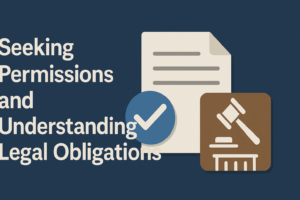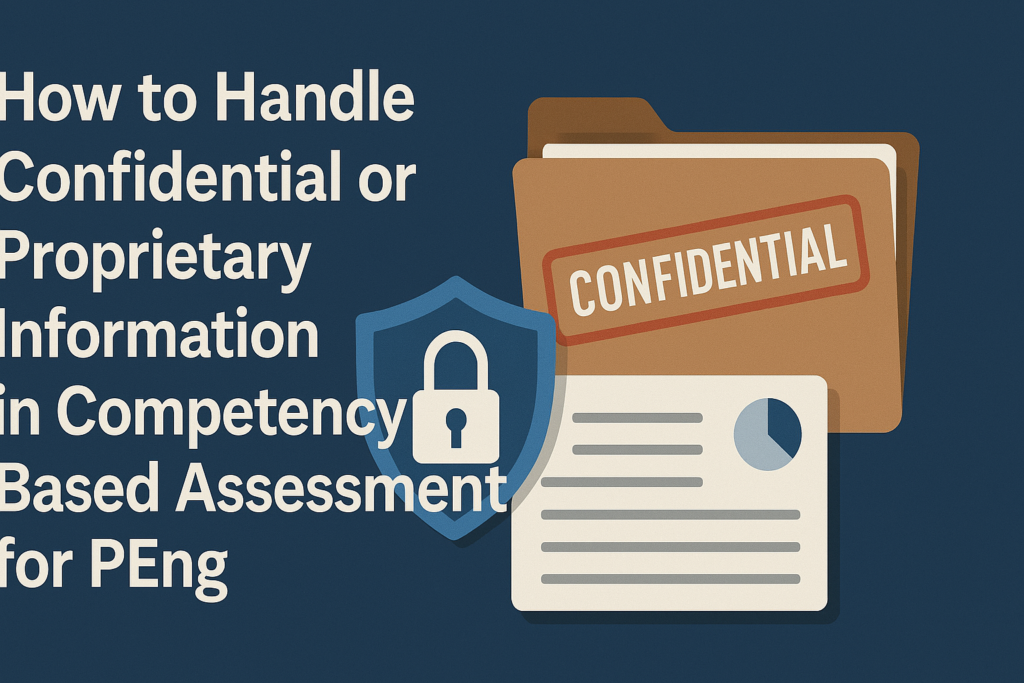Introduction
Competency Based Assessment for PEng is a critical requirement for engineers seeking licensure in Canada. As part of this process, applicants must demonstrate their engineering competencies through detailed examples of work experience. However, these examples often involve confidential or proprietary information, posing a challenge in crafting a submission that is both comprehensive and compliant.
Confidentiality plays a pivotal role in the engineering profession, where professionals frequently work on sensitive projects involving intellectual property, private client data, or strategic processes. Respecting these boundaries is not just ethical—it’s a requirement enforced by engineering regulatory bodies.
This blog offers guidance on how to handle confidential or proprietary information within your Competency Based Assessment submission. We’ll explore how to identify sensitive content, present it responsibly, and align with professional standards to ensure a successful PEng application.
Whether you’re starting your application or refining your final draft, this post equips you with tools to protect confidentiality while showcasing your engineering expertise.
Understanding Confidential and Proprietary Information in Engineering
Confidential information refers to any data or knowledge not intended for public disclosure—this includes client details, trade secrets, internal reports, or unpublished specifications. Proprietary information, meanwhile, typically involves protected innovations, such as patented designs, proprietary algorithms, or intellectual property developed within an organization.
In engineering practice, both types often appear intertwined in project documentation and professional communication. Common examples include:
- Technical specifications of unreleased products
- Engineering methods unique to a company’s process
- Budgetary or strategic planning documents
- Client-specific design criteria or performance data
Properly identifying and respecting these boundaries is not just ethical—it’s a professional obligation enforced by engineering regulatory bodies across Canada.
The Role of Confidentiality in Competency Based Assessment
The CBA framework is built around a series of key competencies that reflect the responsibilities and expectations of a Professional Engineer. These competencies require applicants to illustrate their engineering work experience through specific examples, demonstrating not only technical skills but also ethical judgment, communication, and risk management.
However, this need for detail introduces a challenge: how do you offer compelling, authentic examples while protecting confidential or proprietary elements?
Engineering regulators, such as Professional Engineer Ontario, expect applicants to provide evidence-based accounts that uphold engineering standards—without compromising the interests of past or current employers. It’s a tightrope that demands both precision and discretion.
Guidelines for Handling Confidential Information in CBA Submissions
Identifying Confidential Content
Start by reviewing your work history to pinpoint areas where you handled sensitive materials. Consider whether your contributions involved:
- Client-specific requirements
- Undisclosed technologies or designs
- Contractual details or third-party agreements
- Non-public company processes or metrics
If in doubt, treat the information as confidential and proceed with caution.
Strategies for Anonymizing Sensitive Data
To maintain confidentiality, modify or generalize certain aspects of your project descriptions without losing the essence of your contributions:
- Omit Names: Replace client and project names with descriptors (e.g., “an international automotive firm”).
- Generalize Figures: Use ranges or relative performance indicators (e.g., “achieved a 30–40% efficiency increase”).
- Focus on Your Role: Emphasize your technical approach, problem-solving strategy, and leadership without disclosing trade secrets.
These strategies allow you to meet competency requirements without disclosing protected content.
Seeking Permissions and Understanding Legal Obligations
When unsure about whether certain details can be disclosed, seek permission from your employer or consult your company’s legal department. Some organizations have clear guidelines for external disclosures or may offer support in crafting suitable descriptions.

Keep in mind:
- Non-disclosure agreements (NDAs) remain in effect regardless of your current employment status.
- Legal risks can arise if confidential or proprietary data is mishandled in public submissions.
Always err on the side of caution and transparency—with both your employer and the regulatory authority.
Best Practices for Presenting Work Experience in CBA
Balancing Detail and Discretion
You must strike a balance between offering specific, competency-aligned examples and avoiding the overexposure of confidential data. Focus on these principles:
- Describe the engineering challenge and your solution.
- Highlight tools, frameworks, or methodologies used—without naming proprietary software or tools.
- Demonstrate decision-making processes and outcomes.
This maintains integrity while satisfying the CBA’s requirement for detail and relevance.
Need help refining your CBA submission?
Book a 1-on-1 strategy session with our experts and get hands-on guidance tailored to your engineering background. Our powerful tool, CBA Pro, helps you streamline your submission, structure your competencies, and ensure compliance with regulatory standards. Book now and learn more about CBA Pro.
Utilizing Publicly Available Information
Where possible, use public project references or company-approved case studies. These can support your experience while eliminating concerns about confidentiality.
- Reference industry standards or public benchmarks to frame your contribution.
- Link your role to known engineering practices validated by public sources.
Consulting with Employers or Legal Advisors
If a project was particularly complex or sensitive, consider a review by your employer’s HR or legal department. This proactive step demonstrates professionalism and safeguards your application.
You might also:
- Ask your employer to confirm what content can be shared.
- Use internal templates or language they’ve approved for external use.
- Taking the extra step to verify your descriptions shows respect for professional boundaries and builds confidence in your submission.
Case Studies: Successful CBA Submissions While Maintaining Confidentiality
Let’s look at real-life strategies that engineers have used to pass CBA evaluations while honouring confidentiality agreements.
Case Study 1: The Anonymous Infrastructure Upgrade
An engineer working for a municipality described a wastewater treatment facility upgrade. Instead of naming the site or client, they focused on the engineering process—designing for capacity increase, selecting treatment technologies, and navigating environmental compliance. They omitted proprietary figures but demonstrated strong competency in engineering project management.
Case Study 2: The Proprietary Manufacturing Tool
Another candidate developed a custom automation tool for a manufacturing client. They described their methodology—applying Six Sigma principles, integrating control systems, and managing stakeholder feedback—without revealing the tool’s design. The submission passed with high marks for both technical detail and discretion.
From these examples, the key takeaway is: It’s possible to provide robust evidence while protecting your employer’s or client’s interests.
Conclusion
The Competency Based Assessment for PEng is a vital gateway to joining the professional engineering community in Canada. Yet, it comes with the serious responsibility of safeguarding confidential and proprietary information.
By identifying sensitive content, using anonymization techniques, consulting with stakeholders, and focusing on personal contributions, engineering applicants can confidently navigate their CBA submissions.
If you’re preparing your engineering assessment and unsure how to balance detail with discretion—DiNova Digital Consulting Inc. is here to help. We specialize in supporting professionals through their CBA process while maintaining compliance with engineering standards and ethical practices.
Need expert help preparing your CBA?
Contact us today to ensure your submission is accurate, confidential, and compelling.


